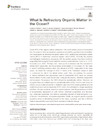Identificador persistente para citar o vincular este elemento:
https://accedacris.ulpgc.es/jspui/handle/10553/107003
| Título: | What Is Refractory Organic Matter in the Ocean? | Autores/as: | Baltar, Federico Alvarez-Salgado, Xosé A. Arístegui, Javier Benner, Ronald Hansell, Dennis A. Herndl, Gerhard J. Lønborg, Christian |
Clasificación UNESCO: | 251001 Oceanografía biológica | Palabras clave: | Carbon Cycle Climate Change Dissolved Organic Carbon Dissolved Organic Matter Refractory Doc |
Fecha de publicación: | 2021 | Proyectos: | Flujos de Carbono en Un Sistema de Afloramiento Costero (Cabo Blanco, Nw de Africa). Papel Del Carbono Disuelto y en Suspension en El Contexto de la Bomba Biologica. e-IMPACT (PID2019-109084RB-C2) Sustainable management of mesopelagic resources |
Publicación seriada: | Frontiers in Marine Science | Resumen: | About 20% of the organic carbon produced in the sunlit surface ocean is transported into the ocean’s interior as dissolved, suspended and sinking particles to be mineralized and sequestered as dissolved inorganic carbon (DIC), sedimentary particulate organic carbon (POC) or “refractory” dissolved organic carbon (rDOC). Recently, the physical and biological mechanisms associated with the particle pumps have been revisited, suggesting that accepted fluxes might be severely underestimated (Boyd et al., 2019; Buesseler et al., 2020). Perhaps even more poorly understood are the mechanisms driving rDOC production and its potential accumulation in the ocean. On the basis of recent conflicting evidence about the relevance of DOC degradation in the deep ocean, we revisit the concept of rDOC in terms of its “refractory” nature in order to understand its role in the global carbon cycle. Here, we address the problem of various definitions and approaches used to characterize rDOC (such as turnover time in relation to the ocean transit time, molecule abundance, chemical composition and structure). We propose that rDOC should be operationally defined. However, we recognize there are multiple ways to operationally define rDOC; thus the main focus for unifying future studies should be to explicitly state how rDOC is being defined and the analytical window used for measuring rDOC, rather than adhering to a single operational definition. We also conclude, based on recent evidence, that the persistence of rDOC is fundamentally dependent on both intrinsic (chemical composition and structure, e.g., molecular properties), and extrinsic properties (amount or external factors, e.g., molecular concentrations, ecosystem properties). Finally, we suggest specific research questions aimed at stimulating research on the nature, dynamics, and role of rDOC in Carbon sequestration now and in future scenarios of climate change. | URI: | https://accedacris.ulpgc.es/handle/10553/107003 | ISSN: | 2296-7745 | DOI: | 10.3389/fmars.2021.642637 | Fuente: | Frontiers in Marine Science [EISSN 2296-7745], v. 8, (Abril 2021) |
| Colección: | Artículos |
Citas SCOPUSTM
49
actualizado el 08-jun-2025
Citas de WEB OF SCIENCETM
Citations
46
actualizado el 08-jun-2025
Visitas
158
actualizado el 05-oct-2024
Descargas
108
actualizado el 05-oct-2024
Google ScholarTM
Verifica
Altmetric
Comparte
Exporta metadatos
Los elementos en ULPGC accedaCRIS están protegidos por derechos de autor con todos los derechos reservados, a menos que se indique lo contrario.
